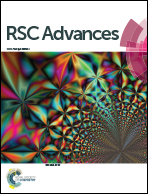Native and functionalized micrometre-sized cellulose capsules prepared by microfluidic flow focusing
Abstract
Cellulose capsules with average outer and inner radii of approximately 44 μm and 29 μm respectively were prepared from cellulose dissolved in a mixture of lithium chloride and dimethylacetamide using a microfluidic flow focusing device (MFFD). The MFFD had three inlets where octane oil in a cellulose solution in silicone oil was used to produce a double emulsion containing a cellulose capsule. This technique enables the formation of capsules with a narrow size distribution which can be beneficial for drug delivery or controlled release capsules. In this respect, cellulose is a highly interesting material since it is known to cause no autoimmune reactions when used in contact with human tissue. Furthermore, by controlling the chemical properties of the cellulose, it is possible to trigger a swelling of the capsules and consequentially the release of an encapsulated substance, e.g. a model drug, when the capsule becomes exposed to an external stimulus. To demonstrate this, capsules were functionalized by carboxymethylation to be pH-responsive and to expand approximately 10% when subjected to a change in pH from 3 to 10. The diffusion constant of a model drug, a 4 kDa fluorescently labelled dextran, through the native capsule wall was estimated to be 6.5 × 10−14 m2 s−1 by fitting fluorescence intensity data to Fick's second law.


 Please wait while we load your content...
Please wait while we load your content...